Many people die each year from vending machines that accidentally fall over. This usually occurs when a product is not dispensed properly, and the machine is “shaken” to dislodge the product. You have a better chance of being electrocuted by a vending machine than winning the lottery. Your odds at winning the lottery vary but can be 1 in 175 million. The odds of being killed by a vending machine are 1 in 112 million.
Imagine, if you will, this scenario. It is late one night, and you decide to go fishing. Problem is the bait shop closed hours ago, but the moon is full, and the white bass is running. Fishing could be no better. What to do, what to do?
Or this scenario…. You are out of town and want to attend a sporting event. You want to fit in with the screaming fans. Problem is you left your tee shirt and hat at the house; you live over five hours away, and this is the only opportunity you have to attend a game. The stores are closed, and you’ve got to have it now! What to do, what to do?
Well, with everything in life comes opportunity. Some entrepreneur “feels your pain” and at the same time desires to make a quick buck. The products above are available to you 24 hours a day and 7 days a week. Enter the vending machine.
Most people are familiar with vending machines. Who hasn’t gotten the urge for a cold drink or a tasty bag of salty chips? Older, more seasoned citizens remember a time where you could get your favorite pack of cigarettes from one of these machines. What requirements did such a machine meet to achieve the status of “vending machine”?
Only the Code book knows!
The provisions for requiring ground-fault circuit-interrupter (GFCI) protection for vending machines were added to Article 422, Appliances, in the 2005 Code cycle. The U.S. Product Safety Commission had investigated four separate electrocutions that resulted in deaths since 1995 and three non-fatal shock hazards. These investigations spurred the new GFCI requirements. Like mostCode changes, a serious injury or death drove these requirements. Some of the unfortunate events happened around pools in hotel environments. Some occurred in other indoor and outdoor areas.
This author investigated one issue outside of a fire department several years ago. Late one evening, after a fire response, a firefighter wanted a soft drink. The barefoot firefighter received a tingle from the machine when he tried to place money into the machine. As the local electrical inspector, I was contacted the following morning. A tester was used, and it was determined that the metal casing of the machine had approximately 70 volts of circulating current on it. The machine was unplugged, and the vending machine provider called to remove the machine. Through sheer chance, a fatal electrocution was adverted in this situation. Had this vending machine been GFCI-protected, the faulty condition would have been discovered much earlier, and the potential danger avoided all together.
With vending machines come GFCI protection
Vending machines require GFCI protection. But what is a GFCI? Again, let’s visit the definitions to see if we can find an answer. This time, we find our help located in Article 100. Let’s see what it says:
Ground-Fault Circuit Interrupter (GFCI). A device intended for the protection of personnel that functions to de-energize a circuit or portion thereof within an established period of time when a current to ground exceeds the values established for a Class A device.
Informational Note: Class A ground-fault circuit interrupters trip when the current to ground is 6 mA or higher and do not trip when the current to ground is less than 4 mA. For further information, see UL 943, Standard for Ground- Fault Circuit Interrupters.(2011 NEC)
Now that we are straight what a GFCI is let’s see where we are required to provide this protection to vending machines. This requirement is found in section 422.51.
422.51 Cord- and Plug-Connected Vending Machines.
Cord- and plug-connected vending machines manufactured or remanufactured on or after January 1, 2005, shall include a ground-fault circuit interrupter as an integral part of the attachment plug or be located within 300 mm (12 in.) of the attachment plug. Older vending machines manufactured or remanufactured prior to January 1, 2005, shall be connected to a GFCI-protected outlet.
Informational Note: For further information, see ANSI/UL 541-2005, Standard for Refrigerated Vending Machines, or ANSI/UL 751-2005, Standard for Vending Machines. (2011 NEC)
I would be remiss not to mention a new requirement for the 2014 NEC that deals with GFCI requirements being extended to vending machines that are “other than” cord- and plug-connected.
422.51 Vending Machines.
(B) Other Than Cord- and Plug-Connected. Vending machines not utilizing a cord and plug connection shall be connected to a ground-fault circuit-interrupter protected circuit.(2014 NEC)
This is important because some of the vending machines you will encounter will not be connected by a cord- and plug-connection. It is essential to know which edition of the Code is being enforced in the jurisdiction in which you are working. Consulting with the local authority having jurisdiction (AHJ) is always a good move on your part. But what if I am the local AHJ? What then? Help is available with interpretations from the NFPA and from other code experts within the electrical industry.
Where can the GFCI device be installed?
A new requirement was placed at 422.5 for the 2014 NEC Code cycle. It reads as follows:
422.5 Ground-Fault Circuit-Interrupter (GFCI) Protection. The device providing GFCI protection required in this article shall be readily accessible. (2014 NEC)
This was an important addition to the Code. A proposal was submitted to Code-making Panel 17 that included substantiation stating that, in many cases, the manufacturers of GFCI devices require routine testing of these devices, usually on a monthly basis. This requirement helps to ensure that the device is providing the protection it was intended to provide. The panel was in agreement and placed this new requirement in the 2014 NEC.
GFCI protection can be supplied by items other than a receptacle. Many are familiar with a circuit breaker being used for this function. Other devices can be located in the attachment cord of the appliance and still need to be readily accessible for observation and testing.
If we look at the definitions, we find one for readily accessible located in Article 100. Let’s look at the definition:
Accessible, Readily (Readily Accessible). Capable of being reached quickly for operation, renewal, or inspections without requiring those to whom ready access is requisite to climb over or remove obstacles or to resort to portable ladders, and so forth. (2011 NEC)
A fully loaded vending machine can be very heavy. Moving it to reset or test the GFCI could be extremely difficult. With the new requirements that were added at 422.5 for the 2014 Code cycle, it has been made clear that GFCI devices are required to be accessible for these appliances.
What is a vending machine?
To begin our search of understanding we need to know what constitutes a vending machine. In order to do that, we need to locate a definition. The makers of the Code have helped us out by including such a definition within the National Electric Code. This definition is located in 422.2 of the 2011 NEC. Let’s review:
Vending Machine. Any self-service device that dispenses products or merchandise without the necessity of replenishing the device between each vending operation and is designed to require insertion of coin, paper currency, token, card, key, or receipt of payment by other means. (2011NEC)
Now look closely at which requirements must be met to achieve the status as vending machine. The definition can be broken into three requirements; all of which must be met. Let’s break it down from the definition:
1. It must be a self-service device.
2. It must dispense a product or merchandise without the necessity of replenishing the device between each vending operation.
3. It must be designed to require insertion of coin, paper currency, token, card, key, or receipt of payment by other means.
Now that we have the requirements broken out, I can see several everyday pieces of equipment that meet these requirements. These pieces of equipment dispense many items other than cold drinks and candy bars. A few examples would be hot coffee, sandwiches, and photo products.
Applying the Requirements
Now we can apply these requirements to items that we might consider a vending machine [see definition of vending machineabove]. I have included a few for your consideration and amusement:

Photo 1. Self Service Drink Cabinet
1. It must be a self-service device.
Okay we are required to get our own drink from the machine. Meets Item #1.
2. It must dispense a product or merchandise without the necessity of replenishing the device between each vending operation.
By the looks of it, this machine meets the requirement of Item #2.
3. It must be designed to require insertion of coin, paper currency, token, card, key, or receipt of payment by other means.
This machine is not designed to accept money or any of the other forms of payment found in Item #3. Therefore, this cannot be considered a vending machine.
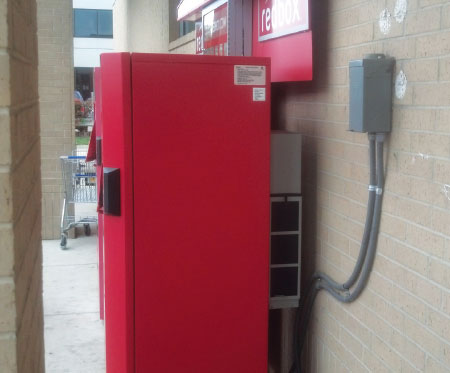
Photo 2. Red Box Video Machine
1. It must be a self-service device.
Okay we can select our movie of choice and is self-service. Meets Item #1.
2. It must dispense a product or merchandise without the necessity of replenishing the device between each vending operation.
This machine dispenses an item until it runs out of the item (similar to a drink machine). Meets Item #2.
3. It must be designed to require insertion of coin, paper currency, token, card, key, or receipt of payment by other means.
This item is designed to accept a payment for dispensing the desired product. Therefore, it can be considered a vending machine. Remember 422.51(B) for other than cord- and plug-connected vending machines.
Photo 3. Fountain Drink Dispenser
1. It must be
a self-service device.Okay we can select our drink of choice, and it is self-service. Meets Item #1.
2. It must dispense a product or merchandise without the necessity of replenishing the device between each vending operation.
This machine dispenses an item until it runs out of the item. Meets Item #2.
3. It must be designed to require insertion of coin, paper currency, token, card, key, or receipt of payment by other means.
This machine is not
designed to accept money or any of the other forms of payment found in Item #3. Typically, the drink is paid for at a counter in the store; therefore, this cannot be considered a vending machine.
Photo 4. ATM Machine
1. It must be
a self-service device.Okay we can select the amount of currency to withdraw, and it is self-service. Meets Item #1.
2. It must dispense a product or merchandise without the necessity of replenishing the device between each vending operation.
This machine dispenses currency until it runs out. Meets Item #2
3. It must be designed to require insertion of coin, paper currency, token, card, key, or receipt of payment by other means.
To use this
item, one must have a bank ATM Card which is inserted to begin the process of receiving a product. This item is designed to accept a payment for dispensing the desired product. Typically, you are charged a fee for the financial transaction. Therefore , it can be considered a vending machine. Or can it? What other factors do we need to consider before making this determination?
Photo 5.
1. It must be a self-service device.
Okay we can select our bait of choice and it is self-service. Meets Item #1.
2. It must dispense a product or merchandise without the necessity of replenishing the device between each vending operation.
This machine dispenses an item until it runs out of the item. Meets Item #2.
3. It must be designed to require insertion of coin, paper currency, token, card, key, or receipt of payment by other means.
This item is designed to accept a payment for dispensing the desired product; therefore, this can be considered a vending machine.
But what about UL and other NRTL Listings?
We have seen some examples of applying the vending machine definition from the NEC to items that inspectors are being asked to inspect on a daily basis. The definition of vending machine states that it must dispense a product or merchandise and require a payment means. I overheard a group of inspectors feverously discussing this topic. Remarks were made that the ATM dispensed a product (money and a receipt), and it also required payment (as in a banking fee that is associated with each transaction). Obviously, there are AHJs encountering items such as these and having to make a determination. Some are coming down on the side of safety and requiring these to have GFCI-protection, using the requirement found for vending machines in Article 422.
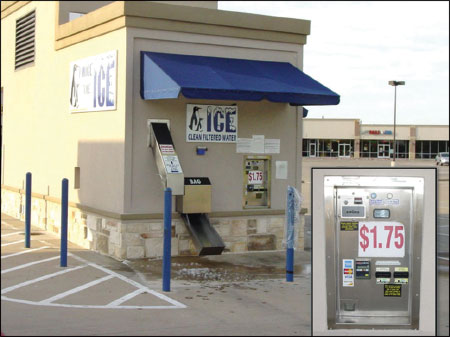
Photo 6. Large ice machine
Let’s see if the Underwriters Laboratory standards or other NRTL (National Recognized Testing Laboratories) have something to say.
ATMs (automatic teller machines) are listed under Banking Equipment (BALT) and evaluated to UL 60950. In reviewing product category (BALT), it does not offer any information towards a requirement for GFCI protection of this equipment. The information here points us towards additional information in category Electrical Equipment for Use in Ordinary Locations (AALZ). The informational notes following the requirements at 422.51 tell us that vending machines are listed to UL 541 or UL 751. This may be an area the installer and the AHJ discuss prior to beginning the project.
As the AHJ, an important document to have and to be familiar with is the most current UL Guide Information for Electrical Equipment (White Book). This document is extremely helpful to the inspector and the installer as to “filling in the blanks” of what is not in the NEC. Find the listing mark on the piece of equipment you are inspection or installing. This will give you information towards finding pertinent information from the standards about this equipment. Use the information on the UL Label and reference the “Index of Product Categories and Industry Terms” in Appendix C of the UL White Book. This will guide you towards the Guide Information for the category. The Guide Information will tell you which standard was used for the listing.
Here are a few of the items that UL 751 includes as types of vending machines:
- Balloon Vending Machines
- Bowl Dispenser Kits
- Candy Vending Machines
- Coffee and Chocolate Vending Machines
- Coffee Vending Machines
- Cup Vending Machines
- Hot Canned-food Vending Machines
- Hot Drink Vending Machines
- Hot Food Vending Machines
- Ice-dispensing Vending Machines
- Oil Can Vending Machines
- Pastry Vending Machines
- Photo Vending Machines
- Water Vending Machines
The standards may or may not provide the necessary information for the AHJ or the installer to make a determination about all equipment that is encountered. Remember to consult the manufacturer’s installation instructions that accompany this equipment. The safety of the end user should be the ultimate concern. Working together, the AHJ and the installer can provide an electrically safe environment for the general public.
Conclusion
Hopefully, we’ve learned something more about vending machines. Today’s society is not your mom and pop society anymore. Society is on the move, and it seems like it never stops. Can you remember going on a peaceful trip to the mountains, or to the beach, and truly saying you had escaped. Nowadays, we take along the cellphone, the laptop, a digital camera, and get there with the help of a GPS device. Our cell phones are always available and keep us from getting lost while traveling to and from our favorite restaurant. During this journey, there are vending machines. From these machines, you can pay for and receive charging services for your cell phone or other electronic devices.
Along the way, there are vending machines that allow us to purchase movies and video games to play in the vehicle to keep the kids quiet and the parents sane on those long trips. Some vending machines even allow us to purchase ice in bulk to ice down the beverages, or maybe, if you’re lucky, that opening day deer carcass for the trip back home.
Vending machines have evolved too. We can get practically anything from these machines. Now that I think of it, there are vending machines that do not require electricity. I wonder if a receptacle is required because they meet the definition of a vending machine, even though they do not require electricity. I’ll leave a little exploring and legwork up to you!
References
Tom Lichtenstein from Underwriters Laboratories for assistance with the UL Standards
NFPA, National Electrical Code, 2011 and 2014 editions
UL Guide Information for Electrical Equipment (White Book), 2013





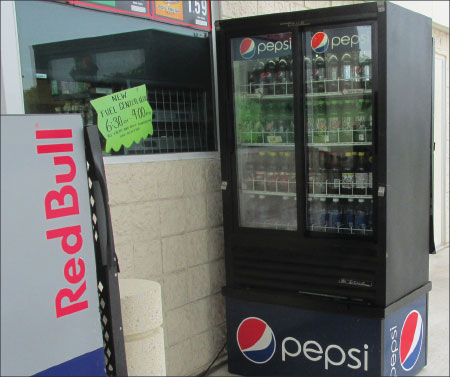
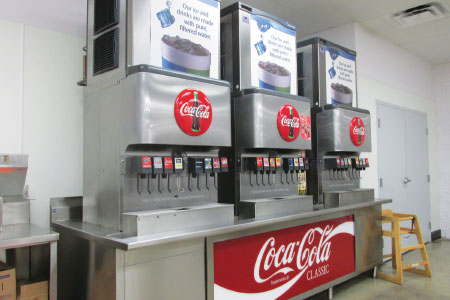
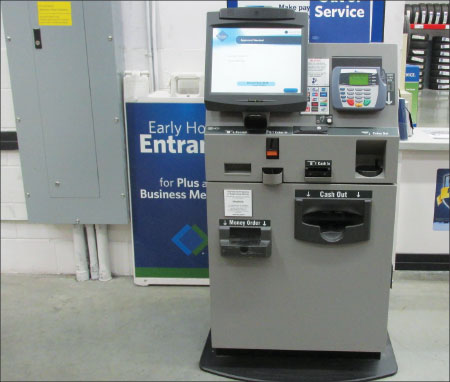
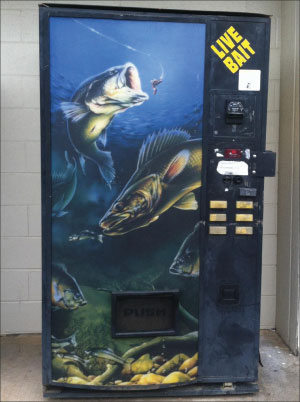






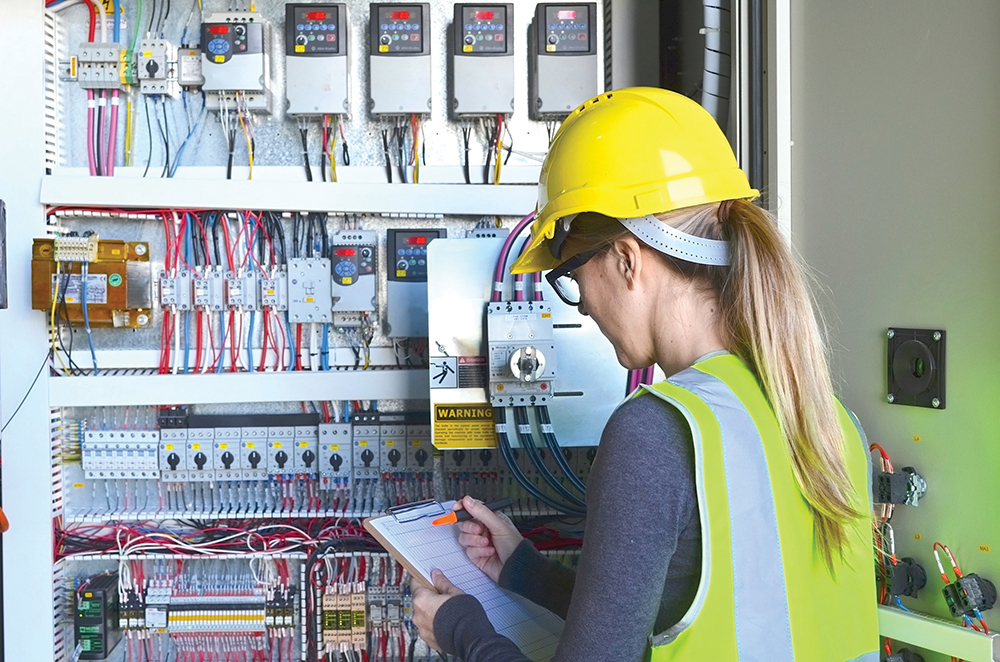
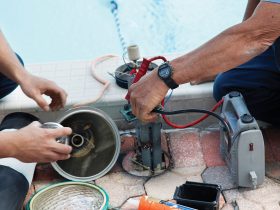

Find Us on Socials